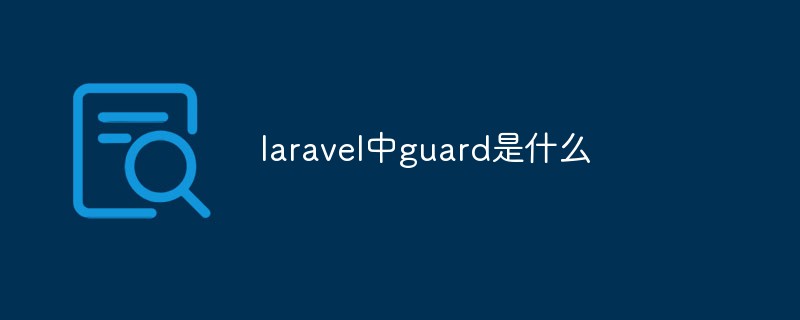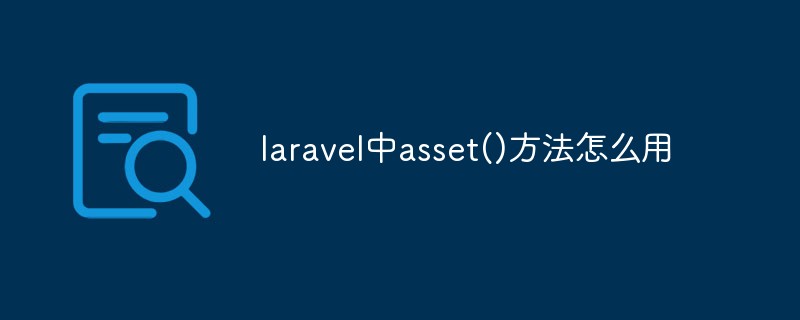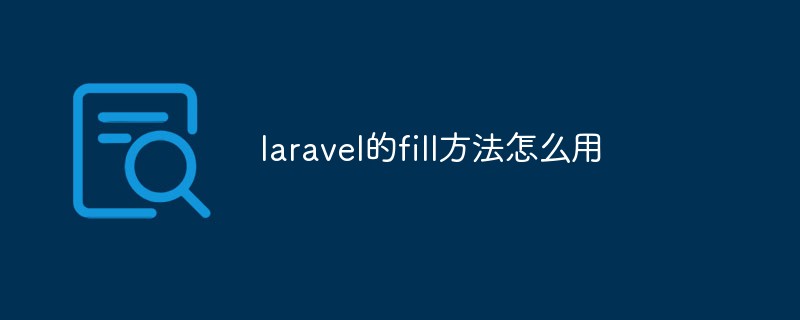Laravel features: 1. The "artisan" command line tool can automate manual work; 2. "Migration" manages database and version control; 3. The testing function is also very powerful; 4. Suitable for various applications Development modes TDD, DDD and BDD; 5. Support Composer package management tool.

Laravel is a simple and elegant PHP Web development framework (PHP Web Framework). It can free you from messy codes like noodles; it can help you build a perfect network APP, and every line of code can be concise and expressive.
Laravel already has an advanced PHP ActiveRecord implementation -- Eloquent ORM. It can easily apply "constraints" to both sides of the relationship, so that you have complete control over the data and enjoy all the conveniences of ActiveRecord. Eloquent natively supports all methods of the query builder (query-builder) in Fluent.
Recommended video tutorial: "PHP Tutorial"
Functional features
1. Grammar update Expressive
Do you know what "true" means in the following line of code?
$uri = Url::create(‘some/uri’, array(), array(), true);
Also, do you know what the other parameters here mean (except the first one)? Of course you don't know. Because this line of code is not expressive.
Look at this code again:
$url = URL::to_secure(‘some/uri’);
This expression creates a URL link using the HTTPS protocol. In fact, the above two ways of writing are doing the same thing, but which one is better? What about being clear at a glance and more expressive?
2. High-quality documentation
Laravel has a great community support. The expressiveness and good documentation of the Laravel code itself make PHP programming a pleasure.
3. Rich expansion packages
Bundle is the name for expansion packages in Laravel. It can be anything - as large as a complete ORM, as small as a debug tool, or just copy & paste to install any extension! Laravel's extension packs are contributed by developers from all over the world, and more are constantly being added.
4. Open source and hosted on GITHUB
Laravel is completely open source. All code is available on Github, and you are welcome to contribute.
Technical Features
1. Bundle is the organization form or name of Laravel’s expansion package. Laravel's extension package repository is quite mature and can easily help you install extension packages (bundles) into your application. You can choose to download an extension package (bundle) and copy it to the bundles directory, or install it automatically through the command line tool "Artisan".
2. Application logic can be implemented in controllers or directly integrated into route statements, and the syntax is similar to the Sinatra framework. Laravel's design philosophy is to give developers maximum flexibility, allowing them to create very small websites and build large-scale enterprise applications.
3. Reverse Routing gives you the ability to create links (URIs) through route names. Just use the route name and Laravel will automatically create the correct URI for you. This way you can change your routes at any time, and Laravel will automatically update all related links for you.
4. Restful Controllers are an optional way to distinguish between GET and POST request logic. For example, in a user login logic, you declare a get_login() action to process the service of obtaining the login page; you also declare a post_login() action to verify the data POSTed from the form, and After authentication, a decision is made to redirect to the login page or to the console.
5. Class Auto-loading simplifies the loading of classes. In the future, you no longer need to maintain the auto-loading configuration table and unnecessary component loading. When you want to load any library or model, just use it immediately, and Laravel will automatically load the required files for you.
6. View Composers are essentially a piece of code that will be automatically executed when the View is loaded. The best example is the random article recommendation on the side of the blog. The "view assembler" contains the logic for loading the random article recommendation. In this way, you only need to load the view of the content area, and Laravel will do the other things. Complete it automatically for you.
7. The reverse control container (IoC container) provides a convenient way to generate new objects, instantiate objects at any time, and access singleton objects. Inverse Control (IoC) means that you almost don't need to load external libraries (libraries), you can access these objects anywhere in the code, and you don't need to endure complicated and redundant code structures.
8. Migrations is like a version control tool, but it manages the database paradigm and is directly integrated into Laravel. You can use the "Artisan" command line tool to generate and execute "migration" instructions. When your team members change the database paradigm, you can easily update the current project through the version control tool, and then execute the "migrate" command. Well, your database is already up to date!
9. Unit-Testing is a very important part of Laravel. Laravel itself contains hundreds of test cases to ensure that any modification will not affect the functionality of other parts. This is one of the reasons why Laravel is considered the most stable version in the industry. Laravel also provides convenient functions to make unit testing your own code easy. All test cases can be run through the Artisan command line tool.
10. The Automatic Pagination function avoids mixing a large amount of irrelevant paging configuration code into your business logic. The convenience is that you don't need to remember the current page, just get the total number of entries from the database, then use limit/offset to get the selected data, and finally call the 'paginate' method to let Laravel output the links of each page to the specified view ( View), Laravel will automatically complete all the work for you. Laravel's automatic paging system is designed to be easy to implement and easy to modify. Although Laravel can handle these tasks automatically, don't forget to call the corresponding methods and manually configure the paging system!
Recommended tutorial: "Laravel"
The above is the detailed content of What are the features of Laravel?. For more information, please follow other related articles on the PHP Chinese website!
 laravel单点登录方法详解Jun 15, 2022 am 11:45 AM
laravel单点登录方法详解Jun 15, 2022 am 11:45 AM本篇文章给大家带来了关于laravel的相关知识,其中主要介绍了关于单点登录的相关问题,单点登录是指在多个应用系统中,用户只需要登录一次就可以访问所有相互信任的应用系统,下面一起来看一下,希望对大家有帮助。
 一起来聊聊Laravel的生命周期Apr 25, 2022 pm 12:04 PM
一起来聊聊Laravel的生命周期Apr 25, 2022 pm 12:04 PM本篇文章给大家带来了关于laravel的相关知识,其中主要介绍了关于Laravel的生命周期相关问题,Laravel 的生命周期从public\index.php开始,从public\index.php结束,希望对大家有帮助。
 laravel中guard是什么Jun 02, 2022 pm 05:54 PM
laravel中guard是什么Jun 02, 2022 pm 05:54 PM在laravel中,guard是一个用于用户认证的插件;guard的作用就是处理认证判断每一个请求,从数据库中读取数据和用户输入的对比,调用是否登录过或者允许通过的,并且Guard能非常灵活的构建一套自己的认证体系。
 laravel中asset()方法怎么用Jun 02, 2022 pm 04:55 PM
laravel中asset()方法怎么用Jun 02, 2022 pm 04:55 PMlaravel中asset()方法的用法:1、用于引入静态文件,语法为“src="{{asset(‘需要引入的文件路径’)}}"”;2、用于给当前请求的scheme前端资源生成一个url,语法为“$url = asset('前端资源')”。
 实例详解laravel使用中间件记录用户请求日志Apr 26, 2022 am 11:53 AM
实例详解laravel使用中间件记录用户请求日志Apr 26, 2022 am 11:53 AM本篇文章给大家带来了关于laravel的相关知识,其中主要介绍了关于使用中间件记录用户请求日志的相关问题,包括了创建中间件、注册中间件、记录用户访问等等内容,下面一起来看一下,希望对大家有帮助。
 laravel中间件基础详解May 18, 2022 am 11:46 AM
laravel中间件基础详解May 18, 2022 am 11:46 AM本篇文章给大家带来了关于laravel的相关知识,其中主要介绍了关于中间件的相关问题,包括了什么是中间件、自定义中间件等等,中间件为过滤进入应用的 HTTP 请求提供了一套便利的机制,下面一起来看一下,希望对大家有帮助。
 laravel的fill方法怎么用Jun 06, 2022 pm 03:33 PM
laravel的fill方法怎么用Jun 06, 2022 pm 03:33 PM在laravel中,fill方法是一个给Eloquent实例赋值属性的方法,该方法可以理解为用于过滤前端传输过来的与模型中对应的多余字段;当调用该方法时,会先去检测当前Model的状态,根据fillable数组的设置,Model会处于不同的状态。
 laravel路由文件在哪个目录里Apr 28, 2022 pm 01:07 PM
laravel路由文件在哪个目录里Apr 28, 2022 pm 01:07 PMlaravel路由文件在“routes”目录里。Laravel中所有的路由文件定义在routes目录下,它里面的内容会自动被框架加载;该目录下默认有四个路由文件用于给不同的入口使用:web.php、api.php、console.php等。


Hot AI Tools

Undresser.AI Undress
AI-powered app for creating realistic nude photos

AI Clothes Remover
Online AI tool for removing clothes from photos.

Undress AI Tool
Undress images for free

Clothoff.io
AI clothes remover

AI Hentai Generator
Generate AI Hentai for free.

Hot Article

Hot Tools

Safe Exam Browser
Safe Exam Browser is a secure browser environment for taking online exams securely. This software turns any computer into a secure workstation. It controls access to any utility and prevents students from using unauthorized resources.

DVWA
Damn Vulnerable Web App (DVWA) is a PHP/MySQL web application that is very vulnerable. Its main goals are to be an aid for security professionals to test their skills and tools in a legal environment, to help web developers better understand the process of securing web applications, and to help teachers/students teach/learn in a classroom environment Web application security. The goal of DVWA is to practice some of the most common web vulnerabilities through a simple and straightforward interface, with varying degrees of difficulty. Please note that this software

SublimeText3 English version
Recommended: Win version, supports code prompts!

EditPlus Chinese cracked version
Small size, syntax highlighting, does not support code prompt function

SublimeText3 Linux new version
SublimeText3 Linux latest version






